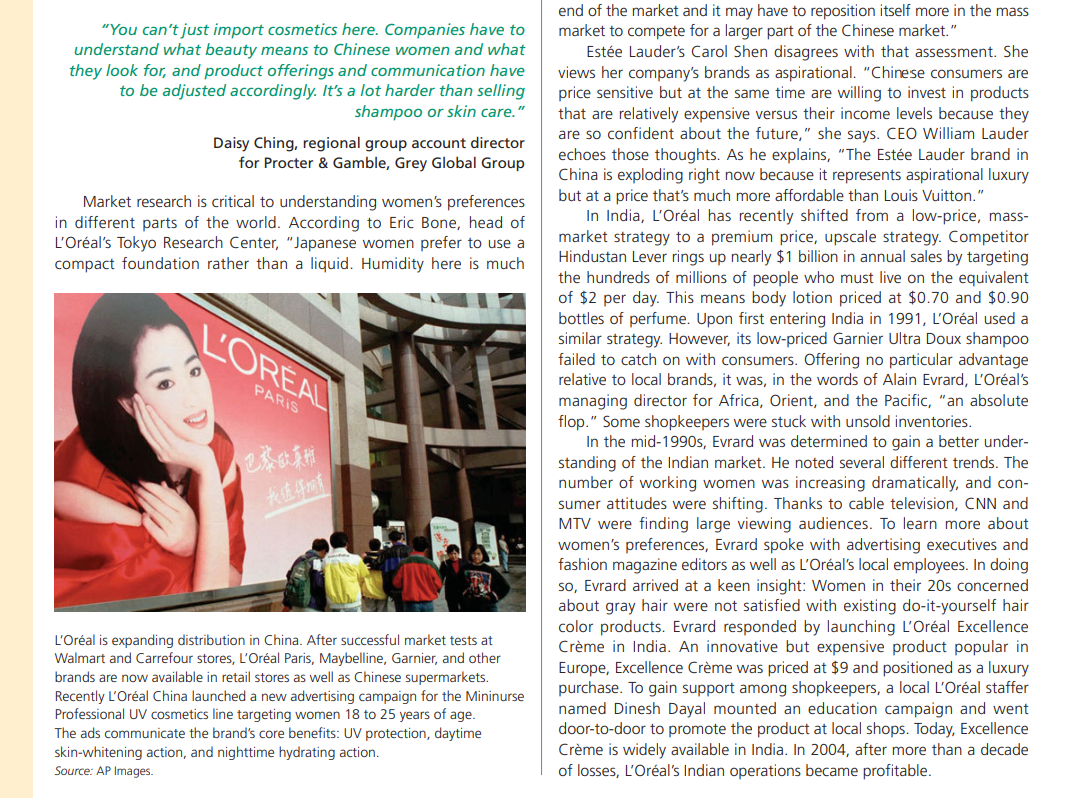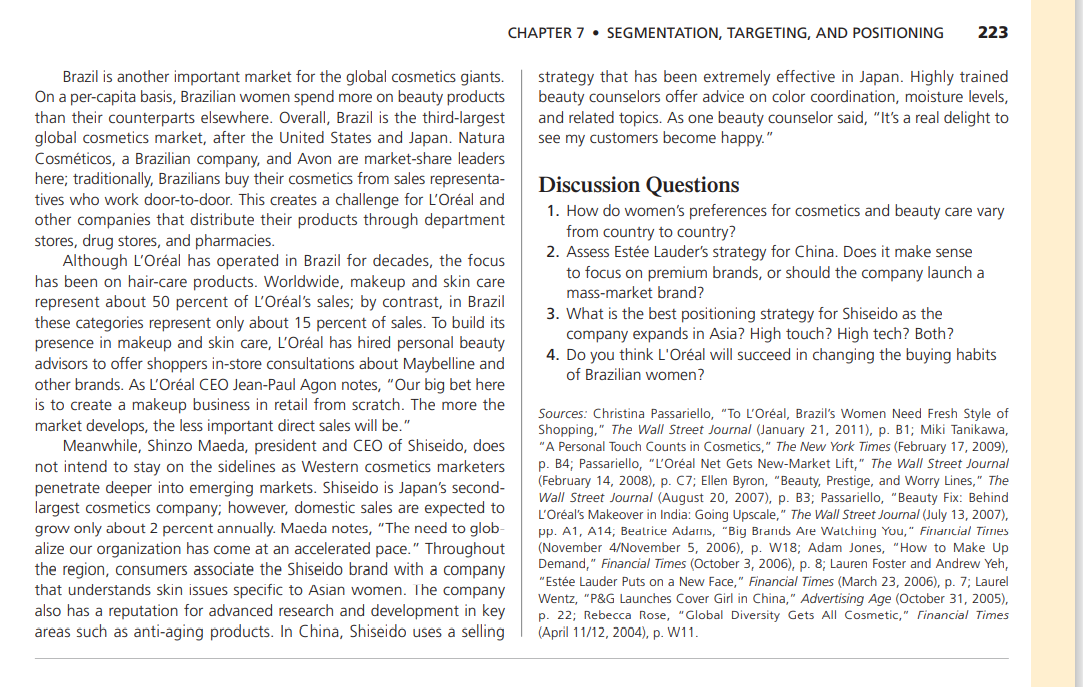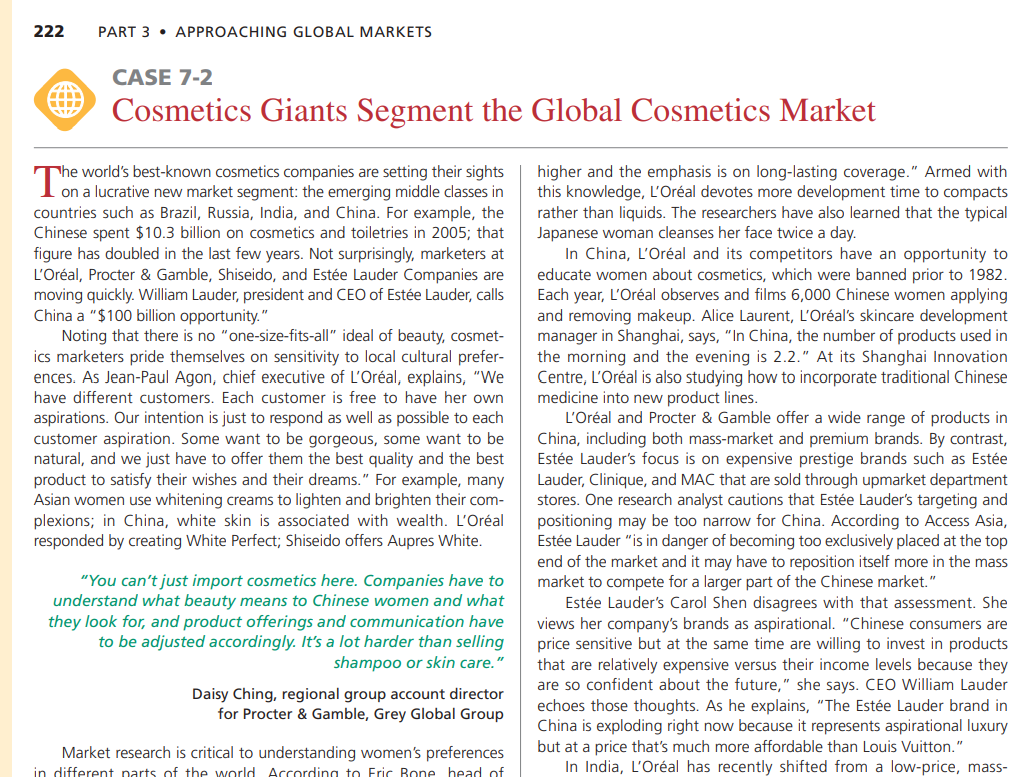Can you help me answer question 1 and 2 in details in the discusion questions part in the below photos? Thank you very much for your work.
end of the market and it may have to reposition itself more in the mass "You can't just import cosmetics here. Companies have to market to compete for a larger part of the Chinese market." understand what beauty means to Chinese women and what Estee Lauder's Carol Shen disagrees with that assessment. She they look for, and product offerings and communication have to be adjusted accordingly. It's a lot harder than selling views her company's brands as aspirational. "Chinese consumers are shampoo or skin care. " price sensitive but at the same time are willing to invest in products that are relatively expensive versus their income levels because they Daisy Ching, regional group account director are so confident about the future," she says. CEO William Lauder for Procter & Gamble, Grey Global Group echoes those thoughts. As he explains, "The Estee Lauder brand in China is exploding right now because it represents aspirational luxury Market research is critical to understanding women's preferences but at a price that's much more affordable than Louis Vuitton." in different parts of the world. According to Eric Bone, head of In India, L'oreal has recently shifted from a low-price, mass- L'oreal's Tokyo Research Center, "Japanese women prefer to use a market strategy to a premium price, upscale strategy. Competitor compact foundation rather than a liquid. Humidity here is much Hindustan Lever rings up nearly $1 billion in annual sales by targeting the hundreds of millions of people who must live on the equivalent of $2 per day. This means body lotion priced at $0.70 and $0.90 bottles of perfume. Upon first entering India in 1991, L'oreal used a similar strategy. However, its low-priced Garnier Ultra Doux shampoo L'OREAL failed to catch on with consumers. Offering no particular advantage relative to local brands, it was, in the words of Alain Evrard, L'oreal's PARIS managing director for Africa, Orient, and the Pacific, "an absolute flop." Some shopkeepers were stuck with unsold inventories. In the mid-1990s, Evrard was determined to gain a better under- standing of the Indian market. He noted several different trends. The number of working women was increasing dramatically, and con- sumer attitudes were shifting. Thanks to cable television, CNN and MTV were finding large viewing audiences. To learn more about women's preferences, Evrard spoke with advertising executives and fashion magazine editors as well as L'oreal's local employees. In doing so, Evrard arrived at a keen insight: Women in their 20s concerned about gray hair were not satisfied with existing do-it-yourself hair L'oreal is expanding distribution in China. After successful market tests at color products. Evrard responded by launching L'oreal Excellence Walmart and Carrefour stores, L'oreal Paris, Maybelline, Garnier, and other Creme in India. An innovative but expensive product popular in brands are now available in retail stores as well as Chinese supermarkets. Europe, Excellence Creme was priced at $9 and positioned as a luxury Recently L'oreal China launched a new advertising campaign for the Mininurse purchase. To gain support among shopkeepers, a local L'oreal staffer Professional UV cosmetics line targeting women 18 to 25 years of age. named Dinesh Dayal mounted an education campaign and went The ads communicate the brand's core benefits: UV protection, daytime door-to-door to promote the product at local shops. Today, Excellence skin-whitening action, and nighttime hydrating action. Creme is widely available in India. In 2004, after more than a decade Source: AP Images. of losses, L'oreal's Indian operations became profitable.CHAPTER 7 . SEGMENTATION, TARGETING, AND POSITIONING 223 Brazil is another important market for the global cosmetics giants. strategy that has been extremely effective in Japan. Highly trained On a per-capita basis, Brazilian women spend more on beauty products beauty counselors offer advice on color coordination, moisture levels, than their counterparts elsewhere. Overall, Brazil is the third-largest and related topics. As one beauty counselor said, "It's a real delight to global cosmetics market, after the United States and Japan. Natura see my customers become happy." Cosmeticos, a Brazilian company, and Avon are market-share leaders here; traditionally, Brazilians buy their cosmetics from sales representa- tives who work door-to-door. This creates a challenge for L'oreal and Discussion Questions other companies that distribute their products through department 1. How do women's preferences for cosmetics and beauty care vary stores, drug stores, and pharmacies. from country to country? Although L'oreal has operated in Brazil for decades, the focus 2. Assess Estee Lauder's strategy for China. Does it make sense has been on hair-care products. Worldwide, makeup and skin care to focus on premium brands, or should the company launch a represent about 50 percent of L'oreal's sales; by contrast, in Brazil mass-market brand? these categories represent only about 15 percent of sales. To build its 3. What is the best positioning strategy for Shiseido as the presence in makeup and skin care, L'oreal has hired personal beauty company expands in Asia? High touch? High tech? Both? advisors to offer shoppers in-store consultations about Maybelline and 4. Do you think L'Oreal will succeed in changing the buying habits other brands. As L'oreal CEO Jean-Paul Agon notes, "Our big bet here of Brazilian women? is to create a makeup business in retail from scratch. The more the market develops, the less important direct sales will be." Sources: Christina Passariello, "To L'oreal, Brazil's Women Need Fresh Style of Meanwhile, Shinzo Maeda, president and CEO of Shiseido, does Shopping," The Wall Street Journal (January 21, 2011), p. B1; Miki Tanikawa, "A Personal Touch Counts in Cosmetics," The New York Times (February 17, 2009), not intend to stay on the sidelines as Western cosmetics marketers p. B4; Passariello, "L'oreal Net Gets New-Market Lift," The Wall Street Journal penetrate deeper into emerging markets. Shiseido is Japan's second- (February 14, 2008), p. C7; Ellen Byron, "Beauty, Prestige, and Worry Lines," The largest cosmetics company; however, domestic sales are expected to Wall Street Journal (August 20, 2007), p. B3; Passariello, "Beauty Fix: Behind grow only about 2 percent annually. Maeda notes, "The need to glob- L'Oreal's Makeover in India: Going Upscale," The Wall Street Journal (July 13, 2007), up. A1, A14; Beatrice Adams, "Big Brands Are Watching You," Financial Times alize our organization has come at an accelerated pace." Throughout (November 4/November 5, 2006), p. W18; Adam Jones, "How to Make Up the region, consumers associate the Shiseido brand with a company Demand," Financial Times (October 3, 2006), p. 8; Lauren Foster and Andrew Yeh, that understands skin issues specific to Asian women. The company "Estee Lauder Puts on a New Face," Financial Times (March 23, 2006), p. 7; Laurel also has a reputation for advanced research and development in key Wentz, "P&G Launches Cover Girl in China," Advertising Age (October 31, 2005), areas such as anti-aging products. In China, Shiseido uses a selling p. 22; Rebecca Rose, "Global Diversity Gets All Cosmetic," Financial Times (April 11/12, 2004), p. W11.222 PART 3 . APPROACHING GLOBAL MARKETS CASE 7-2 Cosmetics Giants Segment the Global Cosmetics Market The world's best-known cosmetics companies are setting their sights higher and the emphasis is on long-lasting coverage." Armed with on a lucrative new market segment: the emerging middle classes in this knowledge, L'oreal devotes more development time to compacts countries such as Brazil, Russia, India, and China. For example, the rather than liquids. The researchers have also learned that the typical Chinese spent $10.3 billion on cosmetics and toiletries in 2005; that Japanese woman cleanses her face twice a day. figure has doubled in the last few years. Not surprisingly, marketers at In China, L'oreal and its competitors have an opportunity to L'Oreal, Procter & Gamble, Shiseido, and Estee Lauder Companies are educate women about cosmetics, which were banned prior to 1982. moving quickly. William Lauder, president and CEO of Estee Lauder, calls Each year, L'oreal observes and films 6,000 Chinese women applying China a "$100 billion opportunity." and removing makeup. Alice Laurent, L'oreal's skincare development Noting that there is no "one-size-fits-all" ideal of beauty, cosmet- manager in Shanghai, says, "In China, the number of products used in ics marketers pride themselves on sensitivity to local cultural prefer- the morning and the evening is 2.2." At its Shanghai Innovation ences. As Jean-Paul Agon, chief executive of L'oreal, explains, "We Centre, L'oreal is also studying how to incorporate traditional Chinese have different customers. Each customer is free to have her own medicine into new product lines. aspirations. Our intention is just to respond as well as possible to each L'oreal and Procter & Gamble offer a wide range of products in customer aspiration. Some want to be gorgeous, some want to be China, including both mass-market and premium brands. By contrast, natural, and we just have to offer them the best quality and the best Estee Lauder's focus is on expensive prestige brands such as Estee product to satisfy their wishes and their dreams." For example, many Lauder, Clinique, and MAC that are sold through upmarket department Asian women use whitening creams to lighten and brighten their com- stores. One research analyst cautions that Estee Lauder's targeting and plexions; in China, white skin is associated with wealth. L'oreal positioning may be too narrow for China. According to Access Asia, responded by creating White Perfect; Shiseido offers Aupres White. Estee Lauder "is in danger of becoming too exclusively placed at the top end of the market and it may have to reposition itself more in the mass "You can't just import cosmetics here. Companies have to market to compete for a larger part of the Chinese market." understand what beauty means to Chinese women and what they look for, and product offerings and communication have Estee Lauder's Carol Shen disagrees with that assessment. She to be adjusted accordingly. It's a lot harder than selling views her company's brands as aspirational. "Chinese consumers are price sensitive but at the same time are willing to invest in products shampoo or skin care." that are relatively expensive versus their income levels because they Daisy Ching, regional group account director are so confident about the future," she says. CEO William Lauder for Procter & Gamble, Grey Global Group echoes those thoughts. As he explains, "The Estee Lauder brand in China is exploding right now because it represents aspirational luxury Market research is critical to understanding women's preferences but at a price that's much more affordable than Louis Vuitton." differ of In India, L'oreal has recently shifted from a low-price, mass









